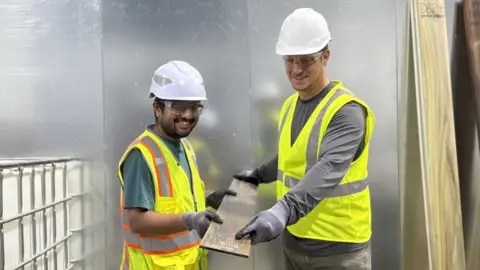Imagine a material stronger than steel, yet made from trees. That’s the promise of Superwood, a breakthrough engineered timber developed by a U.S.-based firm. Unlike conventional wood, this modified version can reportedly stop bullets—at least in lab tests.
During trials, a high-speed projectile blasted through untreated timber but failed to penetrate the reinforced wood. While military applications—like protective shelters—are a possibility, the creators admit they haven’t yet tested it against explosives.
Why Wood? The Push for Greener Building
With the construction industry under pressure to reduce carbon emissions, wood is gaining traction as a sustainable alternative to concrete and steel. Unlike traditional materials, timber actually stores carbon, making it a potential ally in climate mitigation.
But natural wood has limitations—it’s vulnerable to rot, insects, and lacks the strength for large-scale projects. That’s where engineered wood steps in. By chemically treating and compressing lumber, researchers can remove imperfections, boost durability, and even enhance its structural integrity.
How Superwood Works
The process involves stripping lignin—a natural polymer in wood—then compressing the material to reduce its volume by up to 80%. This creates additional hydrogen bonds, making the wood far stronger despite being thinner.
What sets Superwood apart? It retains the natural grain, making it both functional and visually appealing. Initially made from poplar, the company says bamboo—which grows rapidly—could also be used, offering an even more sustainable option.
The Rise of Engineered Timber
Superwood isn’t the only innovation in this space. Products like glulam (glue-laminated timber) and cross-laminated timber (CLT) are already reshaping construction. CLT, for instance, layers wood in alternating directions to create ultra-strong panels. A recent study found that using CLT instead of concrete in a community center could cut emissions by nearly 10%.
Other companies are experimenting too—Germany’s Pollmeier uses beech wood, while Australia’s 3RT repurposes low-value timber to mimic high-end hardwood.
Challenges Ahead
Despite its promise, engineered wood faces hurdles. Insurance and financing for timber buildings can be more complex than for concrete structures. And while Superwood has shown resistance to fire and pests in tests, real-world durability—especially in harsh climates—remains to be seen.
Meanwhile, experts emphasize the importance of recycling existing wood. Even as high-tech timber gains ground, repurposed wood—like that found in particle board furniture—continues to play a crucial role in sustainability.
The Future of Construction?
As architects and builders seek greener solutions, engineered wood could redefine modern construction—from skyscrapers to bullet-resistant facades. The question isn’t just whether wood can replace steel, but how quickly industries will embrace it.
One thing’s clear: the era of supercharged timber has arrived.









